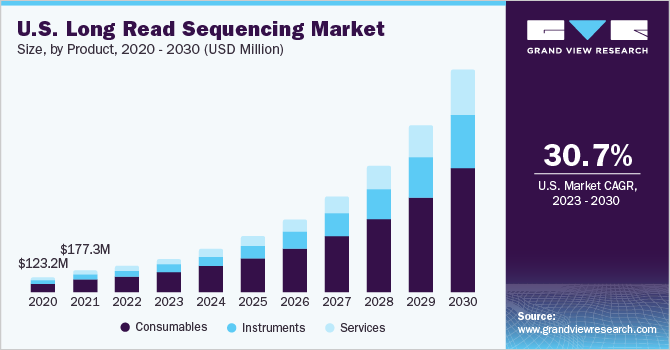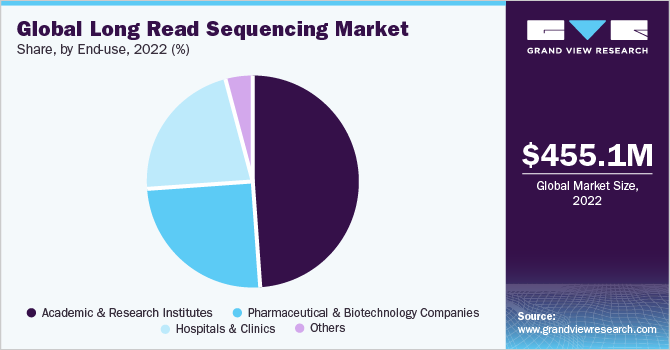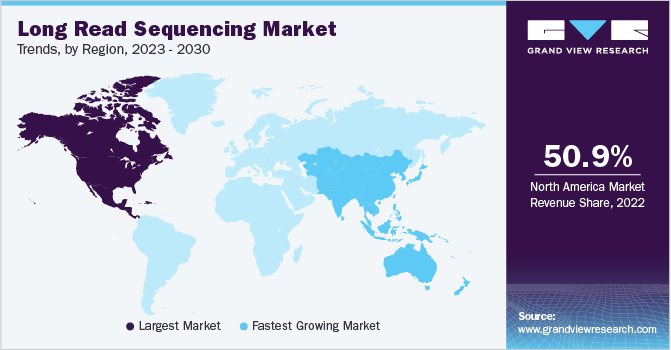- Home
- »
- Biotechnology
- »
-
Long Read Sequencing Market Size & Share Report, 2030GVR Report cover
![Long Read Sequencing Market Size, Share & Trends Report]()
Long Read Sequencing Market Size, Share & Trends Analysis Report By Product, By Technology (Nanopore Sequencing), By Workflow, By Application, By End-Use, By Region And Segment Forecasts, 2023 - 2030
- Report ID: GVR-3-68038-684-4
- Number of Report Pages: 130
- Format: PDF, Horizon Databook
- Historical Range: 2018 - 2021
- Forecast Period: 2023 - 2030
- Industry: Healthcare
Market Size & Trends
The global long read sequencing market size was valued at USD 455.1 million in 2022 and is expected to grow at a compound annual growth rate (CAGR) of 30.92% from 2023 to 2030. The major factors driving the market growth include the rising prevalence of genetic diseases, such as cancers as well as chromosomal disorders, the rising popularity of personalized medicine, and rising technological advancements resulting in the emergence of newer technologies, such as third-generation sequencing. The COVID-19 pandemic has fueled the demand for advanced sequencing techniques for use in diagnostics and drug discovery research. Additionally, long read sequencing can potentially be used to produce high-quality genome assemblies, and for the detection of clinically relevant genome components that cannot be observed using conventional methods. These advantages led to increased adoption of Single Molecule Real Time (SMRT) sequencing and Nanopore techniques for various applications. The long read technique is primarily utilized to investigate genetic disorders where the disease locus is either well-known or strongly suspected.

Long read sequencing (LSR) methods have the ability to get around some of the drawbacks that come with clinical disease investigations based on next-generation sequencing. LSR techniques provide a particular advantage over alternatives due to the utilization of longer reads that come from a single DNA molecule. Real-time sequencing reduces the requirement for batch sampling, resulting in a sequencing run that is less expensive. As a result, the method is useful for the examination of fresh-frozen or fresh samples as well as those that must be examined quickly.
The aforementioned fact has made it possible to accurately analyze complex genomic areas and find large-range aberrations using the long read sequencing method. Since LRS has many advantages over conventional sequencing techniques, it is increasingly being used in a variety of applications. Examples include the inability of techniques like short read sequencing to identify structural variants, discriminate highly homologous genomic areas, sequence repetitive sections, or phase alleles. Such short read limitations widen the diagnostic gap in patients with genetic diseases.
LRS, on the other hand, has the potential to be utilized to create high-quality genome assemblies and to find therapeutically significant genomic components that are difficult to see with traditional techniques. Additionally, it is projected that advancements in long read sequencing will have favorable effects on the market growth in clinical sequencing and analysis. For instance, the method can quickly identify huge variations and complicated structural features that may be related to a variety of clinical problems and rare diseases. Additionally, chromosomal rearrangements and gene fusion events, which are often observed in a number of cancer types, can be easily diagnosed by long read sequencing.
Increasing investment flow by key players in the production of advanced & effective equipment is anticipated to spur market growth throughout the forecasted timeframe. For instance, in January 2022, Illumina Inc. signed a multi-year agreement with Nashville Biosciences for the development of medicines based on large-scale genomic technologies. The company has also collaborated with the German pharmaceutical firm Boehringer Ingelheim to develop companion diagnostics. Such initiatives by companies are expected to foster the market growth in the coming years
Product Insights
In 2022, the consumables segment held the highest market share of 63.37%. End users that perform genome sequencing must purchase consumables on a frequent basis because they are consumed over several sequence runs. Consumables such as assay kits, reagents, etc. have a wide range of applications in sequencing procedures which drive the market. In addition, increasing availability of high-quality reagents from companies such as PacBio and Oxford Nanopore are expected to boost the segment growth.
The services segment is expected to grow at the fastest CAGR of 34.69% from 2023 to 2030 as sequencing services have a variety of applications in cancer research, human genomics, epigenetics, and transcriptome analysis. Furthermore, to ensure that high-quality service is provided through their platforms, major firms like Oxford Nanopore offer certification programs for their service providers which increases the revenue generation opportunities for the services segment.
Technology Insights
The nanopore sequencing segment dominated the market in 2022 with a share of 63.15%. The technology is expected to grow considerably in the future and is expected to revolutionize the long-read sequencing market. Currently, Oxford Nanopore develops array chips that comprise protein nanopores that are fixed onto an electrically resistant polymer. This arrangement allows parallel runs of multiple experiments onto a single chip. The company is currently taking several efforts to enhance the utility of nanopore technology in the future.
The single molecule real time sequencing segment is anticipated to grow at a significant CAGR of 27.26% from 2023 to 2030. This can be attributed to its longer read lengths and low systematic bias leading to achieving high consensus accuracy. Additionally, during sample preparation for SMRT, amplification is not necessary, thereby increasing its adoption in the research community. These factors are likely to boost the adoption of technology in the near future.
Workflow Insights
The sequencing segment accounted for the largest revenue share of 61.79% in 2022. This trend is anticipated to continue throughout the projection period. This is mostly due to the fact that it is one of the most crucial components of the workflow. High demand for reagents and other consumables products for sequencing procedures is one of the key factors driving the segment. Moreover, with the increasing focus on genomics and personalized medicine in recent years, adoption of sequencing activities is expected to witness a rapid growth in the coming years.
The data analysis segment is expected to grow at the fastest CAGR of 33.22% from 2023 to 2030. A high number of algorithms and tools have been developed to carry out base calling, variant discovery, data handling, de novo assembly, and read mapping. Advancements in data analysis tools are expected to boost market growth throughout the forecast period. Key players are expanding their market presence with the help of the development of novel tools and products. For instance, Pacific Biosciences launched Sequel Systems v9.0 Software in July 2020. The SMRT Analysis Software provides flexible command-line options, easy-to-use graphical user interface, and an extensive set of APIs.
Application Insights
The whole genome sequencing segment dominated the long read sequencing market in 2022 with a share of 27.46%. SMRT sequencing has been found to be useful in identification of structural variation in genes as it provides access to a complete size spectrum of genetic variation in whole genomes, transcripts, and genes. The exceptionally long reads of SMRT sequencing allow researchers to discover the hidden biology of cancer samples by resolving isoform diversity, alternative splice sites, gene fusions, and retained introns.
The metagenomics segment is expected to witness the fastest CAGR of 37.00% from 2023 to 2030. Technologies such as SMRT sequencing have been used to carry out metagenomics analyses for HIV, hepatitis C virus, hepatitis B virus, influenza virus, and other disease-causing microbes. The technology has been observed to be useful in not only determining genomic sequences of infecting viruses but also in monitoring any developing mutation due to drug treatment. With the growth in research prospects investigating the metagenomes of highly pathogenic organisms, the segment is expected to witness a rapid growth.
End-use Insights
In 2022, the academic & research institutes segment captured the highest market share of 48.65%. This is owing to the presence of numerous biotechnology research centers that study molecular biology and genome sequencing techniques. Along with this, academic workshops, on-site bioinformatics courses provided by universities, and the rising use of sequence analysis approaches in research are anticipated to strengthen the academic research sector.

The pharmaceutical & biotechnology companies segment is projected to witness the fastest CAGR of 34.59% from 2023 to 2030. Long read sequencing technology's potential in drug discovery and research & development activities is anticipated to drive the category growth. In the upcoming years, it is anticipated that the technology will be able to simplify sequencing analysis for complex genomes and aid in increasing our understanding of chronic disease prognosis. This can lead to the development of novel therapeutic interventions and can drive the segment growth.
Regional Insights
North America dominated the regional market with a share of 50.85% in 2022 due to the presence of major players such as Pacific Biosciences in the area, the availability of a strong informatics network, and well-established rules for the approval and marketing of genomic testing products and services. In addition, it is projected that the growing academic and clinical use of genomic techniques in the U.S. will accelerate the expansion of the North American market.

Asia Pacific is projected to grow at the fastest CAGR of 35.09% from 2023 to 2030 due to the rising investments in the development of cutting-edge diagnostic techniques as well as increased penetration of major players in the region's growing markets. Japan is an emerging market in the Asia Pacific with a booming genomics industry. The Japanese market for long-read sequencing is anticipated to experience significant expansion in the near future as a result of the growing demand for precision medicine and the need for a better knowledge of genetics. For example, in May 2022, Pacific Biosciences collaborated with the Japanese organizations iLAC and Robotic Biology Institute to investigate the automation of the sample preparation workflow for Sequel II and IIe long read sequencing with the use of a robotic laboratory technician.
Key Companies & Market Share Insights
As this is a rapidly growing marketspace, various strategies have been implemented by the key operating players to strengthen their presence in the market. For instance, in March 2023, Illumina launched its high-performance Illumina Complete Long Read Prep, Human assay for conducting human whole-genome sequencing. Some of the key players in the global long read sequencing market include:
-
Pacific Biosciences of California, Inc.
-
Oxford Nanopore Technologies Limited
-
Quantapore, Inc.
-
Element Biosciences
-
BGI Genomics
-
Eurofins Genomics
-
Stratos Genomics, Inc.
-
MicrobesNG
-
NextOmics
-
New England Biolabs
Long Read Sequencing Market Report Scope
Report Attribute
Details
Market size value in 2023
USD 572.9 million
Revenue forecast in 2030
USD 3.78 billion
Growth rate
CAGR of 30.92% from 2023 to 2030
Base year for estimation
2022
Historical data
2018 - 2021
Forecast period
2023 - 2030
Report updated
June 2023
Quantitative units
Revenue in USD million and CAGR from 2023 to 2030
Report coverage
Revenue forecast, company ranking, competitive landscape, growth factors, and trends
Segments covered
Product, technology, workflow, application, end-use, region
Regional scope
North America; Europe; Asia Pacific; Latin America; MEA
Country scope
U.S.; Canada; Germany; UK; France; Italy; Spain; Denmark; Sweden; Norway; China; Japan; India; South Korea; Australia; Thailand; Brazil; Mexico, Argentina; South Africa; Saudi Arabia, UAE; Kuwait
Key companies profiled
Pacific Biosciences of California, Inc.; Oxford Nanopore Technologies Limited; Quantapore, Inc.; Element Biosciences; BGI Genomics; Eurofins Genomics; Stratos Genomics, Inc.; MicrobesNG; NextOmics; New England Biolabs
Customization scope
Free report customization (equivalent up to 8 analyst’s working days) with purchase. Addition or alteration to country, regional & segment scope.
Pricing and purchase options
Avail customized purchase options to meet your exact research needs. Explore purchase options
Global Long Read Sequencing Market Report Segmentation
This report forecasts revenue growth and provides an analysis of the latest trends in each of the sub-segments from 2018 to 2030. For the purpose of this report, Grand View Research has segmented long read sequencing market on the basis of product, technology, workflow, application, end-use and region.
-
Product Outlook (Revenue, USD Million, 2018 - 2030)
-
Instruments
-
Consumables
-
Services
-
-
Technology Outlook (Revenue, USD Million, 2018 - 2030)
-
Single Molecule Real Time Sequencing
-
Nanopore Sequencing
-
Others
-
-
Workflow Outlook (Revenue, USD Million, 2018 - 2030)
-
Pre-sequencing
-
Sequencing
-
Data Analysis
-
-
Application Outlook (Revenue, USD Million, 2018 - 2030)
-
Whole Genome Sequencing
-
Targeted Sequencing
-
Metagenomics
-
RNA Sequencing
-
Epigenetics
- Others
-
-
End-use Outlook (Revenue, USD Million, 2018 - 2030)
-
Academic & Research Institutes
-
Hospitals & Clinics
-
Pharmaceutical & Biotechnology Companies
-
Others
-
-
Regional Scope Outlook (Revenue, USD Million, 2018 - 2030)
-
North America
-
U.S.
-
Canada
-
-
Europe
-
UK
-
Germany
-
France
-
Italy
-
Spain
-
Denmark
-
Sweden
-
Norway
-
-
Asia Pacific
-
Japan
-
China
-
India
-
Australia
-
Thailand
-
South Korea
-
-
Latin America
-
Brazil
-
Mexico
-
Argentina
-
-
Middle East & Africa
-
South Africa
-
Saudi Arabia
-
UAE
-
Kuwait
-
-
Frequently Asked Questions About This Report
b. The global long read sequencing market is expected to grow at a compound annual growth rate of 30.92% from 2023 to 2030 to reach USD 3.78 billion by 2030.
b. Potential applications of long read sequencing in the diagnosis of genetic diseases, epigenetics research, and development of personalized medicine are expected to provide lucrative opportunities to market growth.
b. The global long read sequencing market size was estimated at USD 455.1 million in 2022 and is expected to reach USD 572.9 million in 2023.
b. Some key players operating in the long read sequencing market include Pacific Biosciences of California, Inc.; Oxford Nanopore Technologies Limited; Quantapore, Inc.; Element Biosciences; BGI Genomics; Eurofins Genomics; Stratos Genomics, Inc.; MicrobesNG; NextOmics; and New England Biolabs
b. Key factors that are driving the long read sequencing market growth include the advantages offered by long-read sequencing techniques, potential applications in clinical sequencing and analysis, and advancements in data analysis platforms.
Share this report with your colleague or friend.
![gvr icn]()
NEED A CUSTOM REPORT?
We can customize every report - free of charge - including purchasing stand-alone sections or country-level reports, as well as offer affordable discounts for start-ups & universities. Contact us now
![Certified Icon]()
We are GDPR and CCPA compliant! Your transaction & personal information is safe and secure. For more details, please read our privacy policy.
We are committed towards customer satisfaction, and quality service.
"The quality of research they have done for us has been excellent."





